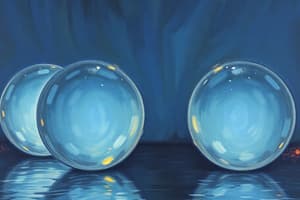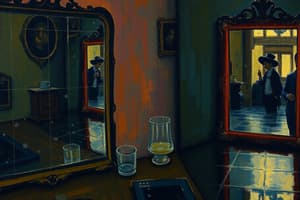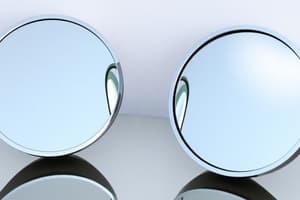Podcast
Questions and Answers
What is the property that distinguishes a mirror from objects that diffuse light?
What is the property that distinguishes a mirror from objects that diffuse light?
- Specular reflection (correct)
- Absorption
- Scattering
- Refraction
Why do waves form an image when focused through a lens after reflecting from a mirror?
Why do waves form an image when focused through a lens after reflecting from a mirror?
- They gain energy from the mirror
- They become polarized after reflecting
- They retain the same degree of curvature and vergence as the original waves (correct)
- They change color after reflecting
What type of surface can act as a mirror?
What type of surface can act as a mirror?
- Smoothened surface
- Textured surface
- Surface with wavelength smaller than the waves (correct)
- Rough surface
What does a plane mirror refer to?
What does a plane mirror refer to?
Mirrors reflect light waves without any change in their curvature and vergence.
Mirrors reflect light waves without any change in their curvature and vergence.
What is the name given to imaginary lines radiating from the light source and always perpendicular to the waves?
What is the name given to imaginary lines radiating from the light source and always perpendicular to the waves?
Specular reflection is the property that distinguishes a mirror from objects that diffuse light.
Specular reflection is the property that distinguishes a mirror from objects that diffuse light.
A mirror can be any surface with a texture or roughness smaller than the wavelength of the waves.
A mirror can be any surface with a texture or roughness smaller than the wavelength of the waves.
Light rays are reflected at an equal angle from which they strike a mirror.
Light rays are reflected at an equal angle from which they strike a mirror.
There are three types of mirrors: concave, convex, and plane.
There are three types of mirrors: concave, convex, and plane.
THE MIRRORS ARE BASICALLY OF TWO TYPES, THEY ARE: 1.) PLANE MIRRORS 2.
THE MIRRORS ARE BASICALLY OF TWO TYPES, THEY ARE: 1.) PLANE MIRRORS 2.
Flashcards
Specular Reflection
Specular Reflection
The property of a surface reflecting light in a predictable, consistent way, like a mirror.
Plane Mirror
Plane Mirror
A mirror with a flat surface.
Mirror Surface Characteristics
Mirror Surface Characteristics
A surface that reflects light with consistent curvature and vergence; its texture must be smaller than the wavelength of the light waves.
Light Rays
Light Rays
Signup and view all the flashcards
Mirror Reflection Angle
Mirror Reflection Angle
Signup and view all the flashcards
Mirror Types
Mirror Types
Signup and view all the flashcards
Image Formation by Mirrors
Image Formation by Mirrors
Signup and view all the flashcards
Mirror Reflection vs Diffuse Reflection
Mirror Reflection vs Diffuse Reflection
Signup and view all the flashcards
Mirror Wavelength
Mirror Wavelength
Signup and view all the flashcards
Concave Mirrors
Concave Mirrors
Signup and view all the flashcards
Convex Mirrors
Convex Mirrors
Signup and view all the flashcards
Study Notes
Properties of Mirrors
- Mirrors are distinguished from objects that diffuse light by specular reflection, which reflects light waves without changing their curvature and vergence.
- Specular reflection occurs when light waves reflect from a surface with a texture or roughness smaller than the wavelength of the waves.
Characteristics of Mirrors
- Mirrors can be any surface with a texture or roughness smaller than the wavelength of the waves.
- Mirrors reflect light rays at an equal angle from which they strike the mirror.
Types of Mirrors
- There are three main types of mirrors: concave, convex, and plane.
- Plane mirrors are a type of mirror that reflects light without changing its curvature or vergence.
Light Rays and Mirrors
- Imaginary lines radiating from the light source, always perpendicular to the waves, are called normal lines.
- Waves form an image when focused through a lens after reflecting from a mirror due to the principle of specular reflection.
Studying That Suits You
Use AI to generate personalized quizzes and flashcards to suit your learning preferences.




